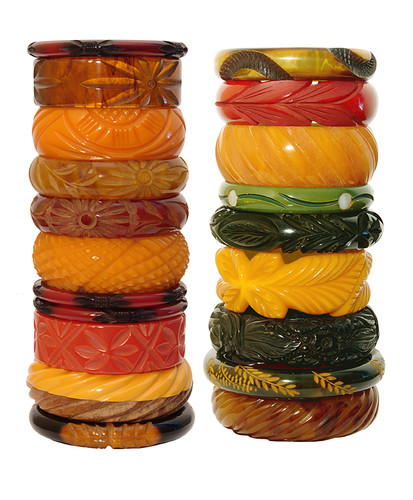I love having an arm full of lovely, warm butterscotch bakelite bracelets. I coordinate outfits just to go with my bangles. When I bought my bakelite bracelets, I knew very little about that fantastic plastic, but I did notice that some of my bracelets had a tiny pinhole burned into it. What's with the pinhole?

Bakelite jewelry is very desired by collectors, and its appearance is often imitated by lesser materials. In an effort to establish that an item is "real" bakelite, some collectors will perform what is called the "hot pin test" on their bakelite items. The hot pin test involves taking an oven-hot pin and pressing the tip into the bakelite item. Since bakelite is thermoset, it cannot be remolded with heat. Thus, a hot pin will not penetrate real bakelite. That means my two "holey" bracelets aren't real bakelite. I call them my fakelites.
Sadly, the obvious problem with the hot pin test is that if your item is bakelite, it is now bakelite with a nasty burn coloration on it, and if it isn't bakelite the damage can range from a hole, like my bracelets, to a complete meltdown.
There are alternative methods to testing bakelite, and these methods are far less destructive. Please consider some of these if you feel you need to test the authenticity of a piece.
The smell test. Heated bakelite will release an odor. Heating bakelite may be as simple as running your hand vigorously over the surface. Hot water may do the trick as well. Mmm...smell that carbolic acid? You've got bakelite!
The sound test. Clacking two bakelite pieces together creates a very distinct sound. The sound is deeper, fuller than acrylic or lucite. When you hear it, you'll know it.
The Forumula 409 test. More reliable to the untrained nose/ear than the above test, the Formula 409 test involves cleaning your bakelite piece, and then touching it with a q-tip doused in 409. If the q-tip yellows, your piece is genuine. People have reported similar results using Scrubbing Bubbles in place of Formula 409.
Of course, all of these tests require you to have the piece in hand. If you are buying on eBay, you don't have these luxuries. When in doubt, ask your seller if the bakelite has been tested, and if so, by what method.
Or, if you are like me, you can just enjoy your beautiful piece of jewelry, even if it is merely a fakelite.
No comments:
Post a Comment